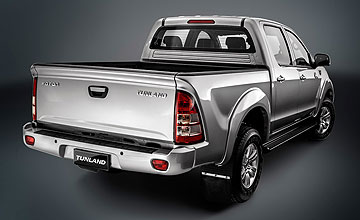BY MIKE COSTELLO | 14th Nov 2012

Fellow Chinese contender Great Wall has enjoyed some success at the bargain-basement end of the ute market, luring plenty of prospective used-car buyers with the promise of something shiny new at the same price as something not.
However, because Foton distributor FAA Australia has priced the Tunland over and above the Great Wall, it will need to hold its own in terms of quality, driveability and – most crucially – reliability.
After a tough day's driving in FAA's home state of Queensland, we found the Tunland too rough-around-the-edges to seriously challenge the big boys, making its price premium over the Great Wall V200 or the SsangYong Actyon hard to justify.
FAA says its pricing mid-way between the best and the rest puts it in the sweet spot, but we would call it more of a no-man's land.
Our test route took in around 200km of various road surfaces and borderline-hardcore trails, and in that time in our top-of-the-line 4x4 version we encountered a panoply of dash rattles, a mystery vibration and hum from behind the odometer and a detached rubber clutch pedal cover.
Another vehicle in our convoy seemed to get stuck in low-range mode.
To the Tunland's credit, it negotiated the rocky track with relative ease – although we gave the underbody protection a scrape or two – and the short second and third gears allowed some steady crawling.
Perhaps not surprisingly, one of the more acceptable elements of the Tunland is the 2.8-litre turbo-diesel engine sourced from US giant Cummins (but built in a new Chinese factory). It takes a moment to spool up but has plenty of huff from 1800rpm right through the mid-range.
It isn't the most refined engine from either inside the cabin or out, however, and the lack of real low-end firepower makes changing down a few cogs on steep hills an unfortunate necessity. Frankly, you shouldn't have to drop back to third gear on a 30-degree climb with no load in the back.
The five-speed manual gearbox – again sourced from a recognised global name, this time German brand Getrag – has a direct and positive shift, and the tall fifth ratio makes up for the lack of a sixth. We found the clutch take-up point a bit awkward, though, and the pedal travel too great.
On winding tarmac, we found road noise relatively subdued, and while the ride was a little jumpy in the back thanks to the leaf springs, it was overall relatively well-damped and comfortable.
Likewise the steering, while nothing special, offered sufficient feel and feedback to somewhat alleviate the rather unwieldy degree of bodyroll and the cumbersome turning circle. This was let down somewhat by an unnerving 'looseness' in the steering column.
The cabin is claimed to offer more space than rivals such as the HiLux and Nissan Navara, but while the rear bench offers plenty of headroom and a comfortable seat-back angle, neither the elbow room or legroom felt up there with the class leaders, and the centre lap-sash belt is an oversight.
Likewise, the lack of stability control and side curtain airbags – even as an option – is a problem that needs to be rectified post-haste if Foton wants to snare some key fleet deals.
The dash itself is full of rattles and squeaks, and the quality of various lids, latches and plastic touch-points on the dash and console felt cheap and second rate. The instrument fascia is bland and old school, and the flagship Luxury is not particularly well-equipped.
Features unavailable on any variant include cruise control, steering wheel audio controls and a full-size USB point (a micro-slot is offered instead) – to name but a few. The leather seats are comfortable in the front, at least.
The rear cargo tray is voluminous, but the lack of a sports-bar on the top-spec model seems incongruous given Foton's target market. FAA claims the 2500kg towing capacity will be upped to 3.3 tonnes soon.
Overall, then, this Tunland fails to cut the proverbial mustard. Priced closer to the Great Wall, it would perhaps be a viable choice, but positioned as it is, we say buy a near-new vehicle from an established brand instead.